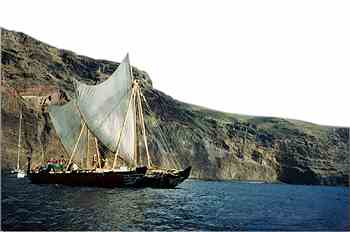Ever since the British explorer, James Cook, on one of his expeditions in 1768, entered Polynesia, Euro-American civilizations have exercised a steadily increasing influence on Polynesian culture.
On his first voyages, Cook was clearly marked by romantic primitivism and by the fascination of "the noble savages".
This was no coincidence. In the time during the exploration of the Pacific Ocean "the noble savages" were en vogue in both England and Paris; the two countries primarily in charge of the 'discovery' of the territory. In Rousseau's description of the American natives the noble savage was the perfect primitive man, living in harmony with his natural surroundings. According to the Danish anthropologist Ole Høiris, among others, the 'noble savage' in the purest form was to be found in Tahiti. In European thought the peoples of Polynesia were chosen to play this part. At the same time, there were other forces in Europe of the day which assumed the attitude that the natives of the Pacific were, for the most part, made up of naked degenerated cannibals.
Thus the Polynesian Islands and peoples achieved a sudden key role in the feud between dege-neracy theorists of the church and evolution theorists of science. For example, the sett-lements of the Pacific appear in Darwin's book Descent of Man, in which he discusses his famous theory of evolution: "survival of the fittest".
However, common to the theories was that it was European past and development that constituted the central object of research. Foreign civilizations were merely used as a means to establish a suitable picture of this past.
The Maohis and the other Polynesian peoples were viewed as closed, homogenous and static cultures and could as such serve for analogies to former European conditions. This was interesting, because so much effort was put into developing a scientific world order, which could form the background for the crucial assertion of identity, which took place during the Enlightment in Europe. But the interest must be viewed always in the light of an aim and means relation. Of course, later, this relation became the basis for the identity which colonial powers forced upon far-off populations.
And it is exactly this identity, that Polynesian peoples today struggle to get rid of and to replace by one more to-lerable to them. Whether one is a "noble savage" or a "dege-nerated cannibal" one will not gain much respect in inter-national politics. The consequence was that the entire Polynesian territory was deprived of independence, primarily by pervasive missionary work.
Because none of the islands represented any sort of material wealth what so ever, there was nothing much to be got there for the colonial powers. Therefore, several of the regions which the European countries had occupied, were eventu-ally left more or less to themselves. Only the USA and France stubbornly held on to 'their territories', and especially French Polynesia has been characterized by most severe colonial politics. The shared experience for the whole territory was that the old colonial identity stuck like glue, and it was through this channel the Euro-American influence lived on.
According to anthropologist J. Friedman, the rise of indigenous peoples movements (fourth world movements), as we have seen it in Polynesia during the last two decades, is coherent with the ongoing political and economic fragmentation, and the apparent collapse of modern Western hegemony and identi-ty. The Polynesians' attempt today to recreate their identity in their own image from original traditions, must therefore be viewed in the perspective of the growing potenti-al ecological catastrophe - terribly foreshadowed by the test bombings in Polynesian atolls - and as a positive alternative to and replacement for the loss of the illusion of eternal progress.
The UN's draft for a declaration of rights for indigenous people(1994) states the significance of contributing to a viable and equal development and proper management of the surroundings by respecting the natives' or indigenous peoples knowledge, cultures and tradi-tional customs. The center of focus for indigenous peoples self-identification is precisely their relation to nature: they live with nature, not by nature.
In the declaration it is maintained that indigenous people have, at any time, the right to revitalize and revive their traditions and customs.
Generally, indigenous peoples' movements distinguish themselves by cultural strategies of life that rely on an already existing fund of authority. Polynesian professor Kame'eleihiwa sees his people as being "(..) deeply rooted in the present, with the back to the future and the eyes pointed towards the past, where he seeks historical answers to contem-porary problems". Such an orientation is practical, says Kame'eleihiwa, "because the future is always unknown, whereas the past is glorious and rich on authority".
An important quality of concepts like culture and tradi-tion is their inherent synchronism of continuity and change. The closed homogeneous and static idea of culture is today being replaced by a more dynamic and open idea of culture. As a consequence, it must be realized that traditions are not ways of doing things that have remained unchanged since the birth of man or since the contact with the Europeans.
If one can talk about a cultural continuity among the Polynesians until today, it must be the symbolical value which lies in the Polynesian double canoe. This is so because of the Polynesians' awareness that, way back when, their fore-fathers landed in Tahiti in this sort of vessel. Had it not been for the double canoe, there would have been no Polynesians. There-fore, more than anything else the double canoe is a common denominator for and a symbol of one of the finest and oldest Polynesian traditions.
By focusing on revitalizing the significance of the double canoe, the Polynesians can strengthen one of their grea-test natural resources and prove that an immemorial tradi-tion has not completely vanished; the unique maritime knowledge of the Polynesians.


